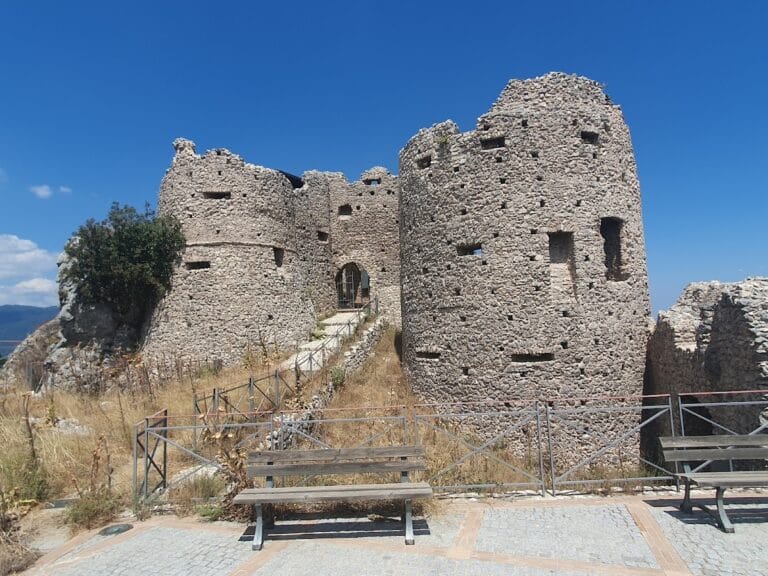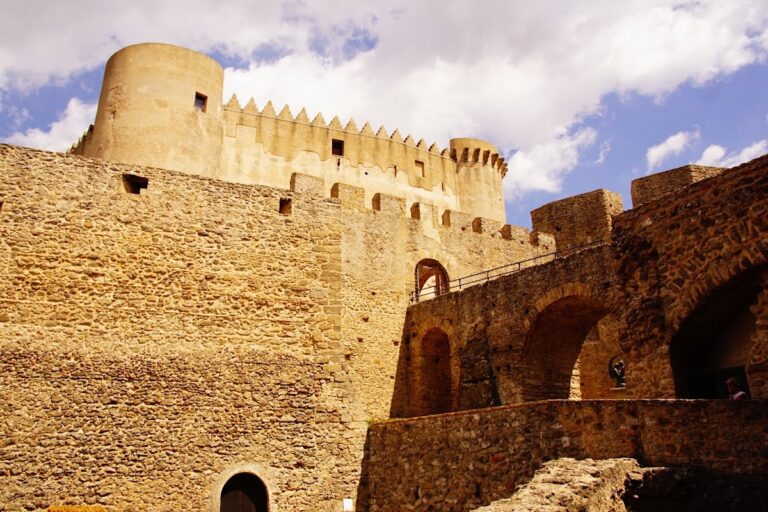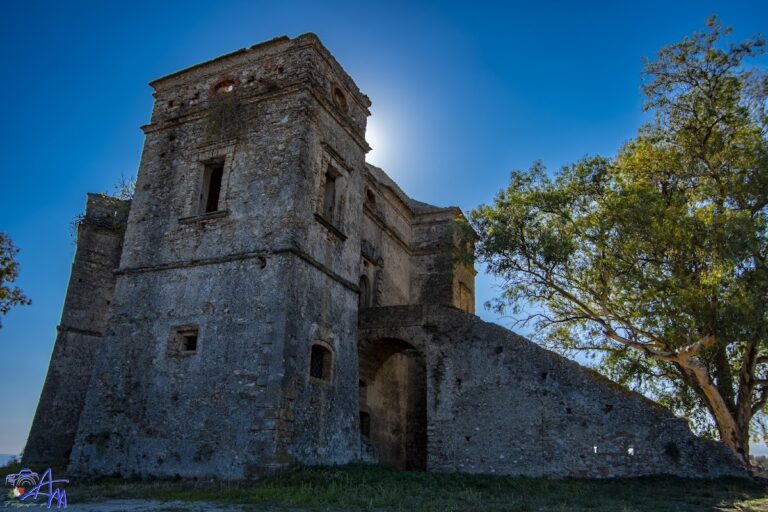Scolacium Archaeological Park: A Greek and Roman Settlement in Calabria, Italy
Table of Contents
Visitor Information
Google Rating: 4.6
Popularity: Medium
Google Maps: View on Google Maps
Official Website: musei.calabria.beniculturali.it
Country: Italy
Civilization: Byzantine, Greek, Roman
Remains: Burial, City, Civic, Domestic, Economic, Entertainment, Infrastructure, Religious, Sanitation
Context
Scolacium Archaeological Park is situated near the contemporary locality of Roccelletta in Calabria, southern Italy. The site occupies a coastal plain adjacent to the Ionian Sea, with an elevated plateau rising nearby. This topographical setting provided the ancient settlement with strategic access to maritime routes and fertile agricultural land, factors that influenced its establishment and growth from the early historic period onward. The surrounding landscape comprises gentle hills and flat expanses conducive to cultivation and habitation, shaping the spatial organization of the settlement over time.
Originally founded as a Greek colony in the 7th century BCE, the site—then known as Skylletion—was part of the broader network of Magna Graecia. Subsequently, it came under Roman dominion, evolving into a municipium during the Imperial era. Archaeological evidence attests to continuous occupation through the Roman period, with the construction of urban infrastructure and public edifices. The site’s decline in late antiquity is documented archaeologically, likely resulting from a combination of seismic events and socio-political instability affecting Calabria and the wider Mediterranean basin.
Modern archaeological investigations, initiated in the 20th century, have uncovered well-preserved remains of Greek and Roman architecture. The site’s partial burial and limited modern development have contributed to the preservation of its stratigraphy and material culture. Current conservation and research efforts aim to safeguard the ruins and enhance understanding of the region’s ancient urban and cultural history.
History
Scolacium Archaeological Park represents a significant example of Greek colonial expansion and Roman urban development in southern Italy. Founded in the 7th century BCE as Skylletion, the settlement occupied a strategic coastal position near the Ionian Sea, integrating into the Magna Graecia network. The site later transitioned to Roman control, attaining municipium status during the Imperial period, reflecting its incorporation into the Roman provincial system. Its decline in late antiquity corresponds with regional disruptions, including natural disasters and political fragmentation.
Greek Period (7th–4th centuries BCE)
The earliest occupation phase at Scolacium dates to the establishment of the Greek colony Skylletion in the 7th century BCE, coinciding with the widespread colonization of southern Italy by Greek city-states. This colonization aimed to secure maritime trade routes and exploit fertile lands. Skylletion’s location near the Ionian Sea and the Gulf of Squillace—referred to by the Greeks as the Sacred Gulf of Athena Skylletikos—underscored its maritime significance and religious association with Athena, the goddess protecting sailors from storms. Archaeological finds, including Greek ceramics, confirm sustained settlement and material culture consistent with other Magna Graecia sites. Although literary references to Skylletion are limited, the site’s integration into regional Greek networks is well established.
Roman Period (3rd century BCE–4th century CE)
Following Roman expansion in southern Italy during the 3rd century BCE, Skylletion was incorporated into the Roman state and renamed Minervia Scolacium, aligning the local cult of Athena with the Roman goddess Minerva. The establishment of a Roman colony at the end of the 2nd century BCE marked a phase of urban development and administrative integration. Archaeological evidence, including inscriptions, attests to the settlement’s status as a municipium, granting it local self-governance under Roman law. The urban fabric expanded to include a forum, public buildings, and defensive walls, reflecting typical Roman municipal organization. The city’s connectivity was enhanced by imperial road networks and maritime trade routes, facilitating economic and social integration within the empire.
Public entertainment structures such as a theater with a capacity of approximately 3,500 spectators and a large amphitheater accommodating between 9,500 and 12,000 individuals were constructed, indicating the city’s role as a regional cultural center. Excavations have revealed domestic architecture, including houses with mosaic floors and hypocaust heating, as well as sculptural artifacts such as marble statues and a notable bronze right arm from a colossal Roman Imperial statue. The city’s economy prominently featured olive cultivation, evidenced by extensive olive groves and later olive oil production. Decline began in the 4th century CE, with abandonment occurring over subsequent centuries amid broader imperial transformations.
Late Antiquity (4th–6th centuries CE)
The late antique period in Calabria was characterized by political fragmentation, Gothic invasions, and seismic activity, including the earthquake of 365 CE. Scolacium experienced a contraction in urban activity, with archaeological layers indicating damage and partial abandonment. Reduced building activity and diminished civic functions reflect the broader decline of Roman urbanism in the region. Some continuity of occupation persisted, possibly involving Romanized inhabitants and early Christian communities, though the settlement’s prominence waned. Economic activities shifted toward subsistence agriculture, with olive cultivation continuing at a smaller scale. Religious life increasingly centered on Christianity, although direct evidence of ecclesiastical structures at Scolacium remains limited.
Byzantine Period (6th–7th centuries CE)
Following the Gothic Wars, Calabria was incorporated into the Byzantine Exarchate of Ravenna. Archaeological evidence at Scolacium indicates minor occupation during this period, including a Byzantine necropolis dating to the 6th–7th centuries CE. The settlement’s role was marginal, with limited new construction and reuse of existing Roman structures. The region faced Lombard incursions, which altered political and military dynamics. Scolacium’s diminished status is reflected in the absence of inscriptions or significant architectural modifications from this era. The community likely consisted of small groups engaged in agriculture and pastoralism, with religious practices aligned to Byzantine Orthodox Christianity.
Medieval and Later Periods
After the Byzantine period, Calabria underwent successive conquests by Lombards, Normans, and later rulers, reshaping the region’s political and cultural landscape. Scolacium itself shows no substantial archaeological evidence of medieval urban occupation. The construction of the Santa Maria della Roccella Abbey in the 11th century, under Norman patronage, marks a shift in regional settlement and religious focus. Intended as one of the largest Romanesque abbeys in Calabria, the church served both spiritual and defensive functions. The abbey remained in use until the earthquake of 1783 and was subsequently repurposed for various utilitarian roles. The original urban center of Scolacium was abandoned, with inhabitants relocating to nearby hilltop settlements, including the foundation of Catanzaro. Agricultural activity, particularly olive cultivation, continued under feudal landowners such as the Mazza family in later centuries.
Daily Life and Importance by Period
Greek Period (7th–4th centuries BCE)
The Greek colonists of Skylletion established a community structured around family units (oikos), with social organization typical of Magna Graecia settlements. The population likely included free male citizens, women, children, and enslaved persons. Men participated in public affairs, while women managed domestic responsibilities. Economic life centered on agriculture, exploiting the fertile coastal plain for cereals, olives, and vines, supplemented by fishing and maritime trade. Archaeological finds such as pottery and tools indicate small-scale artisanal production. The settlement’s coastal position facilitated exchange with other Greek cities, supporting economic sustainability. Dietary staples included bread, olives and olive oil, fish, and wine. Clothing consisted of linen and wool garments typical of Greek attire. Religious observance focused on Athena, reflecting the maritime cultic identity associated with the Sacred Gulf of Athena Skylletikos.
Roman Period (3rd century BCE–4th century CE)
Under Roman rule, Minervia Scolacium exhibited a diverse population comprising Roman settlers, indigenous peoples, and Greek descendants. Inscriptions attest to local magistracies such as duumviri, confirming municipium status and self-governance. The social hierarchy included elite landowners, magistrates, artisans, freedmen, and slaves. Economic activities expanded, with large-scale olive cultivation and olive oil production evidenced by surrounding groves and mechanized mills in later periods. Public infrastructure supported administrative, commercial, and social functions, including a forum, roads, and monumental buildings. Domestic architecture featured mosaic floors and painted walls, indicating aesthetic refinement and social differentiation. The forum served as the civic and commercial center, while the theater and amphitheater hosted cultural and entertainment events. Religious practices syncretized Greek and Roman deities, with Minerva supplanting Athena as the patron goddess.
Late Antiquity (4th–6th centuries CE)
During late antiquity, Scolacium’s population and urban vitality declined. Building activity diminished, and some sectors were abandoned. The social structure contracted, with fewer elite families and reduced civic administration. Seismic damage, including from the 365 CE earthquake, contributed to disruption. Remaining inhabitants likely included Romanized locals and early Christians. Economic life shifted toward subsistence agriculture, with continued olive cultivation. Domestic life became more modest, with simpler household arrangements and fewer luxury goods. Religious life increasingly centered on Christianity, with pagan cults declining. Formal civic institutions and markets diminished, reflecting the broader decline of Roman urbanism in southern Italy.
Byzantine Period (6th–7th centuries CE)
In the Byzantine era, Scolacium’s population was sparse, with minor occupation and reuse of existing structures. The community likely comprised small groups including military personnel, clergy, and peasants. Economic activities focused on local agriculture and pastoralism, with olive cultivation persisting at a subsistence level. Domestic life was simple, lacking elaborate decoration or urban amenities. Religious practices were predominantly Christian Orthodox, aligned with Byzantine ecclesiastical structures. The absence of significant new religious architecture suggests reliance on existing buildings or small chapels. The site functioned as a minor rural outpost within the Byzantine Exarchate, with limited strategic or administrative importance.
Medieval and Later Periods
Following the Byzantine period, Scolacium was effectively abandoned as an urban center. The nearby Norman-era Santa Maria della Roccella Abbey, constructed in the 11th century, reflects a shift toward monastic and rural settlement patterns. The abbey served spiritual and defensive roles, indicating integration into Norman political and ecclesiastical frameworks. Daily life in the vicinity centered on monastic communities and agrarian activities, particularly olive cultivation under feudal landowners such as the Mazza family. The absence of medieval urban remains at Scolacium suggests population relocation to nearby hilltop settlements, including the foundation of Catanzaro. Religious life was dominated by Latin Christianity, with monastic institutions playing key roles in cultural and social organization.
Remains
Architectural Features
The archaeological remains at Scolacium encompass structures primarily from the Greek and Roman periods, with limited evidence of later reuse. The site occupies a coastal plain adjacent to an elevated plateau, where the earliest Greek settlement was established. Construction techniques include ashlar masonry and Roman concrete (opus caementicium), utilizing local limestone and brick materials. The urban layout reveals distinct civic, religious, and residential zones characteristic of a Roman municipium. Phases of expansion and contraction are evident, with the Greek settlement concentrated on the plateau and Roman development extending onto the plain. Late antique contraction and Byzantine reuse are reflected in partial abandonment and fragmentary modifications.
Key Buildings and Structures
Theatre
Constructed in the 1st century CE, the Roman theatre is located on the slope of the elevated plateau. It features a semicircular seating area (cavea) built with stone blocks, partially preserved to the lower tiers. The orchestra, a circular performance space, retains its original form, while the stage building (scaenae frons) survives only in fragments. The theatre’s design follows Roman architectural conventions, including radial staircases and vomitoria for audience access. No significant decorative elements such as statues or frescoes have been documented within the theatre remains. Nearby, the distinctive “Anziano Obeso” marble sculpture from the Flavian dynasty was discovered, attesting to the site’s artistic milieu.
Forum and Basilica
The forum complex, dating to the 1st century CE, occupies a central position within the settlement. It comprises a rectangular open space surrounded by porticoes supported by stone columns, some of which remain standing or partially preserved. Adjacent to the forum is a basilica with a rectangular plan featuring a central nave and side aisles separated by rows of columns. The basilica’s flooring consists of stone slabs, with evidence of later repairs. Both structures exhibit ashlar masonry and brickwork typical of Roman civic architecture. The forum served as the administrative and commercial heart of the municipium.
Amphitheater
The amphitheater is a large Roman structure capable of accommodating between 9,500 and 12,000 spectators. It was used for gladiatorial games and other public spectacles. Excavated remains include substantial portions of the seating and arena, forming a prominent feature of the archaeological park. The amphitheater’s scale indicates the settlement’s capacity to host significant regional events.
Public Baths
Located on the lower plain near the forum, the public baths date to the 2nd century CE. The complex includes a caldarium (hot bath), tepidarium (warm bath), and frigidarium (cold bath) arranged linearly. Hypocaust heating systems are preserved in parts of the caldarium and tepidarium, consisting of raised floors supported by small pillars. Walls constructed of brick-faced concrete survive to varying heights, and mosaic flooring fragments with geometric patterns have been uncovered. The baths were supplied by a cistern system, traces of which remain visible near the complex.
Temple Remains
On the elevated plateau, foundations and partial walls of a temple dating to the late 4th century BCE have been excavated. The structure’s podium and stylobate are preserved in situ, constructed with large limestone blocks. The cella layout is discernible, though no columns remain standing. Architectural fragments such as column drums and capitals found nearby suggest a peripteral design with columns surrounding the cella. No inscriptions or decorative sculptures directly linked to the temple have been recovered, leaving its dedication uncertain.
Necropolises
The necropolis lies outside the main settlement area and includes tombs dating from the 4th century BCE through the Roman Imperial period. Excavated graves comprise both inhumation and cremation burials, with stone-built chamber tombs and simple pit graves documented. Some tombs feature funerary stelae and fragmentary inscriptions. Grave goods such as pottery and personal items indicate varied burial customs over time. A Byzantine necropolis dating to the 6th–7th centuries CE has also been identified, confirming continued, though reduced, occupation during the Byzantine period.
Roman Houses
Excavations near the forum have uncovered remains of Roman domestic buildings. These structures include stone foundations and brick walls, with some rooms containing mosaic floors and hypocaust heating systems. The houses reflect typical Roman urban domestic architecture, illustrating aspects of daily life and social status within the municipium.
Santa Maria della Roccella Church
Constructed in the 11th century under Norman patronage, the Santa Maria della Roccella Abbey is a large Romanesque basilica located near the entrance to the olive plantation owned by the Mazza family. Built as a single-nave church, it was intended to be one of the largest abbeys in Calabria but remained incomplete. The abbey served multiple functions over time: as a place of worship until the 1783 earthquake, a defensive structure, and later as an animal pen. Its tall red-brick walls survive as imposing ruins, reflecting the architectural style and political-religious context of Norman Calabria.
Olive Oil Factory Museum
Situated within the archaeological park on the site of a historic olive mill, the Olive Oil Factory Museum documents the history of olive oil production in the region. The mill was mechanized and electrified in the 19th century by the Mazza family, who were prominent landowners. The museum integrates agricultural heritage with archaeological exhibits, illustrating the continuity of olive cultivation from antiquity to modern times.
Scolacium Archaeological Museum
Housed in the renovated residence of Baron Mazza near the forum, the Scolacium Archaeological Museum displays artifacts spanning from the Paleolithic period to the Roman Imperial era. Collections include stone tools, Greek and Bruttii ceramics, and Roman marble sculptures. Notable pieces comprise a scratched marble female statue, a delicately draped female figure, a colossal bronze right arm measuring 81 cm from the 2nd century CE, and the “Anziano Obeso” sculpture from the Flavian dynasty. The bronze arm belonged to a statue approximately twice life-size, underscoring the artistic production at the site.
Preservation and Current Status
The preservation of Scolacium’s ruins varies by structure. The theatre’s seating and orchestra remain partially intact, while the stage building is fragmentary. The forum and basilica retain substantial wall sections and column bases, with some columns stabilized using modern materials. The baths’ hypocaust system and mosaic fragments are preserved but exposed to environmental weathering. Temple foundations survive in situ, though no superstructure remains. Necropolis tombs are generally well-preserved but require ongoing conservation to prevent deterioration.
Restoration efforts have prioritized structural stabilization and protection from erosion and vegetation overgrowth. Some areas have been consolidated with modern reinforcements, while others remain in situ without reconstruction. The site faces challenges such as soil erosion and occasional vandalism. Local heritage authorities continue excavation and conservation programs, balancing preservation with controlled public access.
Unexcavated Areas
Significant portions of Scolacium remain unexcavated or only partially investigated. Surface surveys and geophysical prospections have identified subsurface anomalies suggestive of additional residential quarters and possible industrial zones on the plain. The eastern sector near the coastline has not been systematically excavated, though historic maps indicate potential buried remains. The necropolis extends beyond currently excavated tombs, with surface finds indicating further burial sites. Conservation policies and modern land use limit intrusive excavation, but non-invasive surveys continue to refine understanding of the site’s extent and urban development.










